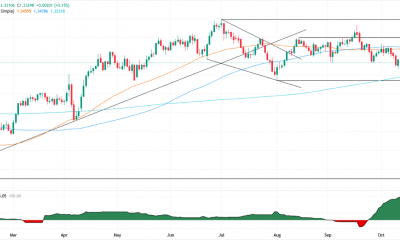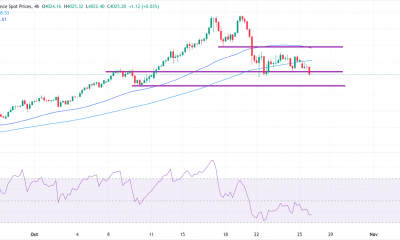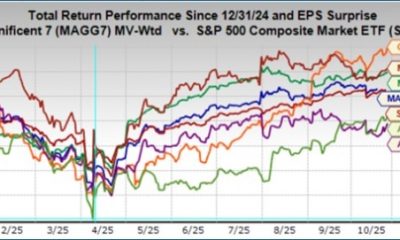

others
Mexican Peso remains on the backfoot as market mood falters – Crypto News
- Mexican Peso gets hit by sentiment shifting, down 0.13% against Greenback.
- Mexico’s economy continues to slow down amid the ongoing disinflation process.
- Expectations that Banxico would begin easy monetary policy in Q1 2024 could pave the way for further upside in USD/MXN.
The Mexican Peso (MXN) extends its losses in the mid-North American session against the US Dollar (USD) this amid thin liquidity conditions in the observance of Martin Luther King (MLK) day in the United States (US). The emerging market currency is soft despite interest rate traders expecting the US Federal Reserve (Fed) to cut rates by 170 basis points in 2024, undermining the prospects of the buck. Nevertheless, the USD/MXN trades at 16.90 on Monday, gaining 0.23%.
Risk aversion is taking its toll on European stocks, bolstering the Greenback (USD), a headwind for the Mexican currency. Even though the Peso continues to edge lower, futures positions on the Mexican Peso show investors had remained long for the last 44 weeks, according to data revealed by the Chicago Board of Trade (CBOT). Net speculative contracts rose by 88,439 longs, -0.7% less than last week’s 89,100.
Despite that, the USD/MXN had resumed its uptrend on speculation that the Bank of Mexico (Banxico) will begin easing its monetary policy. However, the latest inflation report could prevent them from relaxing monetary conditions.
Daily digest market movers: Mexican Peso retreats as investor mood deteriorates
- The latest US inflation report on the producer side affected the markets the most, according to Société Generale. Even though the Consumer Price Index (CPI) in the US was hotter than expected last Thursday, a day later the Producer Price Index (PPI) came lower than estimates, prompting investors to increase odds for a Fed rate cut in March from 78% to 83%. Nevertheless, those odds had eased to 70% at the time of writing.
- Mexican economic data revealed throughout the month suggests the country faces some challenges. Inflation rose from 4.32% to 4.66% YoY in December, exceeding the 4.55% forecast. The same report revealed that underlying inflation is easing toward 5% but remains high, which might deter Banxico officials from easing policy in the first quarter of 2024.
- In addition to that, Industrial Production plunged -1.0% MoM after achieving eight months of expansion, indicating that higher interest rates set by Banxico at 11.25% are beginning to impact the economy.
- In that regard, Auto Production for December slumped from 18.1% to -9.9% YoY.
- Confidence surveys released on January 3 and 8 showed that businesses’ confidence remained high at 54.6, bolstered by “nearshoring” prospects. However, consumers have begun to turn pessimistic as they expect inflation and economic deceleration to weigh on their economies.
- The week’s Mexican economic docket will feature Retail Sales for November, expected to remain unchanged at 3.4% YoY, according to the consensus.
- Last Wednesday, the World Bank revised its economic projections for Mexico in 2024. The updated forecast anticipates that Mexico’s Gross Domestic Product (GDP) will grow by 2.6%, an increase from the bank’s initial prediction of 1.9%. Analysts at the bank attribute this expected growth to the rise in near-shoring activities, which they believe will positively impact the Mexican economy.
- Although the recent meeting minutes from Banxico (the Central Bank of Mexico) suggest that the central bank might contemplate easing its monetary policy, the inflation report for December could hinder any move toward policy relaxation.
- Analysts at Standard Chartered noted, “We expect the policy rate to be lowered to 9.25% by end-2024, although an official downward revision in the output gap could open the door for more aggressive rate cuts.”
- On January 5, a Reuters poll suggested the Mexican Peso could weaken 5.4% to 18.00 per US Dollar in the 12 months following December.
Technical analysis: Mexican Peso weakens as USD/MXN climbs toward 16.90
The USD/MXN remains downward biased, but today’s bullish impulse can open the door to challenging the 17.00 figure. A decisive breach of the latter would expose the 50-day Simple Moving Average (SMA) at 17.19, followed by the confluence of the 100 and 200-day SMAs at around 17.38/40.
On the flip side, if sellers drag prices toward last Friday’s low of 16.82, that could open the door for further downside. Once cleared, the next support would be the January 8 low of 16.78, followed by the August 28 cycle low of 16.69, ahead of last year’s low of 16.62.
USD/MXN Price Action – Daily Chart
Risk sentiment FAQs
In the world of financial jargon the two widely used terms “risk-on” and “risk off” refer to the level of risk that investors are willing to stomach during the period referenced. In a “risk-on” market, investors are optimistic about the future and more willing to buy risky assets. In a “risk-off” market investors start to ‘play it safe’ because they are worried about the future, and therefore buy less risky assets that are more certain of bringing a return, even if it is relatively modest.
Typically, during periods of “risk-on”, stock markets will rise, most commodities – except Gold – will also gain in value, since they benefit from a positive growth outlook. The currencies of nations that are heavy commodity exporters strengthen because of increased demand, and Cryptocurrencies rise. In a “risk-off” market, Bonds go up – especially major government Bonds – Gold shines, and safe-haven currencies such as the Japanese Yen, Swiss Franc and US Dollar all benefit.
The Australian Dollar (AUD), the Canadian Dollar (CAD), the New Zealand Dollar (NZD) and minor FX like the Ruble (RUB) and the South African Rand (ZAR), all tend to rise in markets that are “risk-on”. This is because the economies of these currencies are heavily reliant on commodity exports for growth, and commodities tend to rise in price during risk-on periods. This is because investors foresee greater demand for raw materials in the future due to heightened economic activity.
The major currencies that tend to rise during periods of “risk-off” are the US Dollar (USD), the Japanese Yen (JPY) and the Swiss Franc (CHF). The US Dollar, because it is the world’s reserve currency, and because in times of crisis investors buy US government debt, which is seen as safe because the largest economy in the world is unlikely to default. The Yen, from increased demand for Japanese government bonds, because a high proportion are held by domestic investors who are unlikely to dump them – even in a crisis. The Swiss Franc, because strict Swiss banking laws offer investors enhanced capital protection.
-

 Blockchain1 week ago
Blockchain1 week agoXRP Price Gains Traction — Buyers Pile In Ahead Of Key Technical Breakout – Crypto News
-

 Technology1 week ago
Technology1 week agoSam Altman says OpenAI is developing a ‘legitimate AI researcher’ by 2028 that can discover new science on its own – Crypto News
-

 Technology1 week ago
Technology1 week agoBenQ MA270U review: A 4K monitor that actually gets MacBook users right – Crypto News
-

 De-fi1 week ago
De-fi1 week agoBittensor Rallies Ahead of First TAO Halving – Crypto News
-

 Technology1 week ago
Technology1 week agoGiving Nvidias Blackwell chip to China would slash USs AI advantage, experts say – Crypto News
-

 Technology1 week ago
Technology1 week agoMicrosoft ‘tricked users into pricier AI-linked 365 plans,’ says Australian watchdog; files lawsuit – Crypto News
-

 De-fi1 week ago
De-fi1 week agoAI Sector Rebounds as Agent Payment Systems Gain Traction – Crypto News
-

 Blockchain1 week ago
Blockchain1 week agoBig Iran Bank Goes Bankrupt, Affecting 42 Million Customers – Crypto News
-
Business1 week ago
Crypto Market Rally: BTC, ETH, SOL, DOGE Jump 3-7% as US China Trade Talks Progress – Crypto News
-

 others1 week ago
others1 week agoBank of Canada set to cut interest rate for second consecutive meeting – Crypto News
-

 Business1 week ago
Business1 week agoStarbucks Says Turnaround Strategy Drives Growth in Global Sales – Crypto News
-

 Blockchain1 week ago
Blockchain1 week agoIBM Set to Launch Platform for Managing Digital Assets – Crypto News
-

 Blockchain1 week ago
Blockchain1 week agoSolana Eyes $210 Before Its Next Major Move—Uptrend Or Fakeout Ahead? – Crypto News
-

 De-fi1 week ago
De-fi1 week agoREP Jumps 50% in a Week as Dev Gets Community Support for Augur Fork – Crypto News
-

 Technology1 week ago
Technology1 week agoDonald Trump as Halo Master Chief? White House joins GameStop’s ‘End of Console Wars’ celebration – Crypto News
-

 others1 week ago
others1 week agoGBP/USD floats around 1.3320 as softer US CPI reinforces Fed cut bets – Crypto News
-

 others5 days ago
others5 days agoMETA stock has lower gaps to fill – Crypto News
-

 Blockchain1 week ago
Blockchain1 week agoWhat Happens When You Don’t Report Your Crypto Taxes to the IRS – Crypto News
-
Business1 week ago
Crypto ETFs Attract $1B in Fresh Capital Ahead of Expected Fed Rate Cut This Week – Crypto News
-

 De-fi1 week ago
De-fi1 week agoCrypto Market Edges Lower While US Stocks Hit New Highs – Crypto News
-

 Cryptocurrency1 week ago
Cryptocurrency1 week agoWestern Union eyes stablecoin rails in pursuit of a ‘super app’ vision – Crypto News
-
Technology1 week ago
Pi Coin Price Jumps 24% as 10M Tokens Exit Exchanges – Can Bulls Sustain the Momentum? – Crypto News
-

 De-fi1 week ago
De-fi1 week agoCrypto Phones Struggle as Solana Quietly Pulls Plug on Saga – Crypto News
-
others1 week ago
Pi Coin Gains Another 15% As Pi Network Joins ISO 20022 For Seamless Banking Integration – Crypto News
-

 De-fi1 week ago
De-fi1 week agoBitcoin Dips Under $110,000 After Fed Cuts Rates – Crypto News
-

 De-fi1 week ago
De-fi1 week agoMetaMask Fuels Airdrop Buzz With Token Claim Domain Registration – Crypto News
-

 De-fi1 week ago
De-fi1 week agoTokenized Nasdaq Futures Enter Top 10 by Volume on Hyperliquid – Crypto News
-
others1 week ago
Crypto Market Tumbles as Jerome Powell Says December Rate Cut ‘Far From Certain’ – Crypto News
-
others1 week ago
Is Changpeng “CZ” Zhao Returning To Binance? Probably Not – Crypto News
-

 Cryptocurrency1 week ago
Cryptocurrency1 week agoCitigroup and Coinbase partner to expand digital-asset payment capabilities – Crypto News
-

 Cryptocurrency1 week ago
Cryptocurrency1 week agoInside Bitwise’s milestone solana ETF launch – Crypto News
-
others1 week ago
Can ASTER Price Rebound 50% as Whale Activity and Bullish Pattern Align? – Crypto News
-

 others1 week ago
others1 week agoGold weakens as US-China trade optimism lifts risk sentiment, focus turns to Fed – Crypto News
-

 Cryptocurrency1 week ago
Cryptocurrency1 week agoGold Price Forecast 2025, 2030, 2040 & Investment Outlook – Crypto News
-

 Metaverse1 week ago
Metaverse1 week agoIt isn‘t just AI. Earnings and the economy show the rally has legs. – Crypto News
-

 De-fi1 week ago
De-fi1 week agoCRO Jumps After Trump’s Truth Social Announces Prediction Market Partnership with Crypto.Com – Crypto News
-

 Cryptocurrency1 week ago
Cryptocurrency1 week agoKERNEL price goes vertical on Upbit listing, hits $0.23 – Crypto News
-

 Cryptocurrency1 week ago
Cryptocurrency1 week agoWhy Is Pi Network’s (PI) Price Up by Double Digits Today? – Crypto News
-

 Cryptocurrency1 day ago
Cryptocurrency1 day agoAndrew Tate Buys $5 Million Worth of Bitcoin Hours Before Crash – Crypto News
-

 Blockchain1 week ago
Blockchain1 week agoCrypto Analyst Shows The Possibility Of The Ethereum Price Reaching $16,000 – Crypto News
-
Business1 week ago
$2.5T Citigroup Partners With Coinbase to Enable Stablecoin Payments – Crypto News
-

 Cryptocurrency1 week ago
Cryptocurrency1 week agoArgentine Stablecoin Use Surged Ahead of President Milei’s Midterm Election Win – Crypto News
-

 Metaverse1 week ago
Metaverse1 week agoIt isn‘t just AI. Earnings and the economy show the rally has legs. – Crypto News
-
Cryptocurrency1 week ago
Is Stock Tokenization Really Exploding? Not Even 0.01% – Crypto News
-
Technology1 week ago
Breaking: $2.6B Western Union Announces Plans for Solana-Powered Stablecoin by 2026 – Crypto News
-

 Blockchain1 week ago
Blockchain1 week agoVisa To Support Four Stablecoins on Four Blockchains – Crypto News
-
Cryptocurrency5 days ago
After 1,993% Burn Spike, Is Shiba Inu Price Set for a Major Trend Reversal? – Crypto News
-

 Cryptocurrency1 week ago
Cryptocurrency1 week agoXRP Reversal Sends Price Towards $1, DOGE Treasury to Go Public, Bitcoin Beats Gold, Binance’s CZ Pardoned — Top Weekly Crypto News – Crypto News
-
Cryptocurrency1 week ago
XRP News: Ripple-Backed Evernorth Amasses Over $1B in XRP Ahead of Nasdaq Listing – Crypto News
-

 others1 week ago
others1 week agoPreviewing Mag 7 earnings: What investors should know – Crypto News






